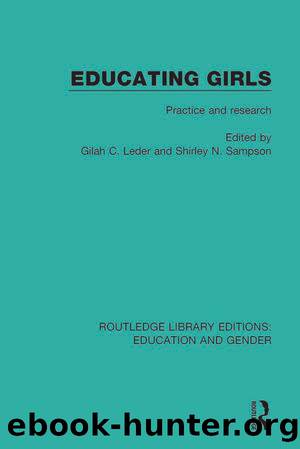Educating Girls by Leder Gilah C.;Sampson Shirley N.; & Shirley N. Sampson

Author:Leder, Gilah C.;Sampson, Shirley N.; & Shirley N. Sampson [Leder, Gilah C. & Sampson, Shirley N.]
Language: eng
Format: epub
Publisher: Taylor & Francis Group
Published: 2017-04-29T00:00:00+00:00
7
GILAH C.LEDER
Do girls count in mathematics?
The Victorian Government will consider recommendations for pay increases for science and mathematics teachers and for all girl classes in co-educational schools.
In a plan to increase student numbers in maths, science and technology subjects, there is also a call for a shake-up in teacher trainingâ¦
Girls [are described] as a âlargely untapped reservoir of scientific talentâ.
(BUTTON, 1987, P.3)
Gender difference in relation to achievement and participation in mathematics continues to attract much attention, from the research community as well as from government bodies. While few consistent differences in performance in mathematics are reported at the early primary school level, there is a substantial body of evidence to suggest that at the beginning of secondary schooling boysâ superiority in mathematics starts to manifest itself. The differences are particularly marked when above average performance is considered (Benbow & Stanley, 1983; Bondi, 1987; Kissane, 1986; Leder, 1980).
A variety of explanations, interrelated rather than self-contained, have been put forward to account for gender differences in mathematics learning. A number of these, teacher as well as learner-related, were examined in the study reported here through a careful monitoring of Grade 7 mathematics lessons. Of particular interest were teacher-student interactions, studentsâ perceptions of their own mathematical ability, and studentsâ attitudes to mathematics and self-rating of ability.
PREVIOUS RESEARCH
Teacher-student interactions
Interaction between teachers and boys and girls has been examined in a variety of ways. Monitoring dyadic interactionsâbetween teachers and single studentsâ(Brophy and Good, 1970) and noting time intervals spent by teachers waiting for and engaging with students (Rowe, 1974a; 1974b) are two observation schedules that have been widely used. Both approaches have identified differences in the ways girls and boys in the same classroom are treated by their teachers.
Boys are typically found to have more interactions than girls with their teachers, both teacher and student initiated. Boys often receive more direct questions, more discipline, and are praised more often than girls for correct answers. Furthermore, high-achieving boys have been reported as having more teacher interactions than high-achieving girls. Such findings have been reported from a diversity of settings. Among American data are those of Good, Sikes and Brophy (1973), Brophy and Good (1974), and Fennema and Peterson (1985), as well as Becker (1981), Eccles and Blumenfeld (1985) and Reyes (1984), who focused on mathematics classes at the secondary school level. Differences in favour of boys have also been reported by Galton, Simon and Croll (1980), and Spender (1982), working in English schools, and by Moore and Smith (1980) in Papua New Guinea. Yet, according to Day (1987) in a recent review of literature, Australian studies in this area are rare.
Much of the work on waiting for and engaging with students has been carried out in science and language arts classes (Tobin, 1987) and has focused on the effects on student achievement of manipulating wait time in particular. In these studies gender differences have usually not been a variable of interest. However, Gore and Roumagoux (1983) reported that Grades 4 and 5 teachers had a longer wait time for boys than girls in mathematics lessons.
Download
This site does not store any files on its server. We only index and link to content provided by other sites. Please contact the content providers to delete copyright contents if any and email us, we'll remove relevant links or contents immediately.
The Art of Coaching Workbook by Elena Aguilar(50161)
Trainspotting by Irvine Welsh(21070)
Twilight of the Idols With the Antichrist and Ecce Homo by Friedrich Nietzsche(18316)
Fangirl by Rainbow Rowell(8812)
Periodization Training for Sports by Tudor Bompa(7939)
Change Your Questions, Change Your Life by Marilee Adams(7399)
This Is How You Lose Her by Junot Diaz(6470)
Asking the Right Questions: A Guide to Critical Thinking by M. Neil Browne & Stuart M. Keeley(5378)
Grit by Angela Duckworth(5316)
Red Sparrow by Jason Matthews(5218)
Paper Towns by Green John(4820)
Room 212 by Kate Stewart(4760)
Ken Follett - World without end by Ken Follett(4461)
The Sports Rules Book by Human Kinetics(4090)
Housekeeping by Marilynne Robinson(4078)
Double Down (Diary of a Wimpy Kid Book 11) by Jeff Kinney(3950)
Papillon (English) by Henri Charrière(3937)
The Motorcycle Diaries by Ernesto Che Guevara(3798)
Exercise Technique Manual for Resistance Training by National Strength & Conditioning Association(3794)
